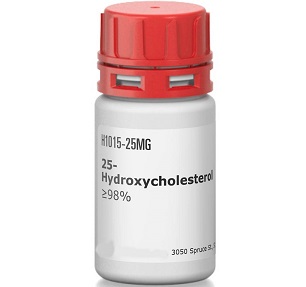COVID-19 Drugs: U.S. NIH Murine Study Shows Finds That Endogenous And Therapeutic 25-Hydroxycholesterols Worsens Early SARS-CoV-2 Pathogenesis!
Thailand Medical News Team Aug 25, 2023 1 year, 7 months, 3 weeks, 2 days, 22 hours, 40 minutes ago
COVID-19 Drugs: The COVID-19 pandemic, caused by the severe acute respiratory syndrome coronavirus 2 (SARS-CoV-2), has triggered unprecedented research efforts to understand the virus's behavior and identify potential treatments. Amid this global crisis, the search for therapeutic agents that can combat the virus has led scientists to explore the properties of 25-hydroxycholesterols (25HC), oxidized forms of cholesterol with multifaceted biological roles. A recent study conducted by the U.S. National Institutes of Health (NIH) delved into the effects of endogenous and therapeutic 25HC on early SARS-CoV-2 pathogenesis using mice models, shedding light on the potential therapeutic applications of these molecules.
 Oxysterols and Their Diverse Biological Functions
Oxysterols and Their Diverse Biological Functions
Oxysterols, specifically 25-hydroxycholesterol (25HC), have garnered significant attention due to their intriguing antiviral properties. Derived from cholesterol through the activity of the enzyme cholesterol-25-hydroxylase (CH25H), 25HC has demonstrated its ability to inhibit a wide range of enveloped viruses, including influenza A, herpes simplex virus-1, HIV, and hepatitis viruses B and C. This antiviral effect is attributed to 25HC's modification of host cell membranes, inhibiting viral fusion and possibly impacting various stages of the viral life cycle. Moreover, 25HC's potential as an anti-inflammatory agent has been explored, showcasing its capacity to dampen inflammasome activation and promote the resolution of lung inflammation.
Antiviral Potential Against SARS-CoV-2
The
COVID-19 Drugs study under scrutiny aimed to unravel the effectiveness of 25HC as a potential therapeutic against SARS-CoV-2 infection. Although previous reports had suggested that 25HC could inhibit SARS-CoV-2 infection, the current investigation did not yield the expected outcomes. In vitro experiments demonstrated that while 25HC displayed antiviral activity against the human endemic coronavirus-229E, it failed to inhibit SARS-CoV-2. Moreover, in vivo trials using murine models infected with SARS-CoV-2 and treated with supplemental 25HC did not reveal significant reductions in viral titers or alterations in disease outcomes. These findings hinted at the complexity of 25HC's effects on different viral infections, necessitating a more nuanced understanding of its interactions with specific viruses.
Unveiling the Mechanistic Discrepancy
The conflicting outcomes between prior studies and the current investigation could be attributed to various factors. Differing experimental conditions, including choice of cell lines, virus strains, and timing of 25HC treatment, might contribute to the divergent results. Interestingly, enantioselectivity was observed in the antiviral effects of 25HC, suggesting that the molecule might trigger protein-dependent effects at low concentrations and alternative protein-independent mechanisms at higher concentrations. The disparity in susceptibility of SARS-CoV-2 and hCoV-229E to 25HC might be influenced by variations in plasma membrane cholesterol content or differential sensitivity to mechanisms impacting viral protein expression.
Th
e In Vivo Scenario
Moving beyond the in vitro setting, the study delved into the effects of supplemental 25HC and CH25H deletion on SARS-CoV-2 infection in murine models. Contrary to the report of reduced lung viral load after 25HC treatment in mice infected with the mouse-adapted SARS-CoV-2 strain, the present investigation did not observe comparable outcomes. The dosing regimen, route of administration, and mouse strain might contribute to the discrepancies between the studies.
Additionally, mice deficient in CH25H, responsible for endogenous 25HC production, were still capable of controlling viral replication, hinting at potential involvement of alternative enzymes in 25HC biosynthesis. The intricate interplay between 25HC and the immune response, especially during late-phase resolution of virus-induced inflammation, remains an avenue for future exploration.
Role of 7α,25HC and EBI2 in SARS-CoV-2 Pathogenesis
The study delved into the downstream effects of 25HC metabolism, particularly the conversion of 25HC to 7α,25-dihydroxycholesterol (7α,25HC) through the enzyme CYP7B1. The bioactive lipid 7α,25HC is known to bind to Epstein Barr Virus-induced gene 2 (EBI2) receptor, promoting immune cell migration to the lung. Although the absence of 7α,25HC signaling did not significantly alter early viral control in the lungs of Gpr183-deficient mice, the intricate role of 7α,25HC and EBI2 in the immune response necessitates further investigation.
Unraveling Pulmonary Endothelial Barrier and Future Directions
A noteworthy finding of the study was the elevation of bronchoalveolar lavage fluid (BALF) albumin, indicating microvascular injury, in mice treated with 25HC. This outcome implicated 25HC's effect on the pulmonary endothelial barrier, a potential target of SARS-CoV-2. Prior reports had highlighted 25HC's cytotoxicity to endothelial cells, and its impact on pulmonary vascular biology warrants more extensive investigation.
Towards Improved Therapeutic Strategies
While the study's outcomes challenge the direct therapeutic potential of 25HC against SARS-CoV-2, they underscore the complexity of oxysterols' actions and interactions with different viruses. As researchers endeavor to explore alternative routes for delivering 25HC to its primary cellular target, respiratory epithelial cells, strategies like formulation with cationic lipid nanovesicles and conjugation with viral fusion inhibitory peptides emerge as potential avenues. Furthermore, the study emphasizes the need for cautious interpretation of findings from studies involving different viruses and underscores the importance of rigorous experimental design.
Conclusion
The NIH study has shed light on the intricate and nuanced interactions between 25-hydroxycholesterols and SARS-CoV-2, offering insights into their potential as antiviral agents. The investigation's results highlight the importance of understanding the mechanisms underlying 25HC's effects and its interactions with different viruses. While the therapeutic potential of 25HC against SARS-CoV-2 might be limited, the study contributes to our broader understanding of viral pathogenesis and the intricate interplay between host cells, viruses, and therapeutic agents. As scientists continue to explore innovative approaches to combat the COVID-19 pandemic, these findings underscore the need for comprehensive investigations and a holistic understanding of the complex biological landscape.
The study findings were published in the peer reviewed American Journal of Respiratory Cell and Molecular Biology.
https://www.atsjournals.org/doi/abs/10.1165/rcmb.2023-0007OC
For the latest on
COVID-19 Drugs, keep on logging to Thailand Medical News.
